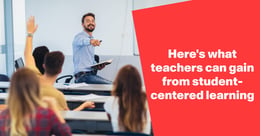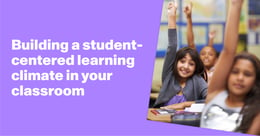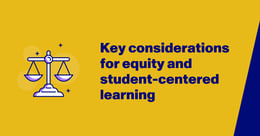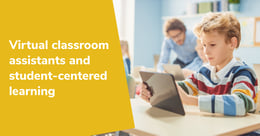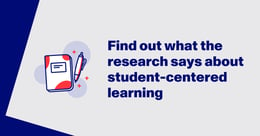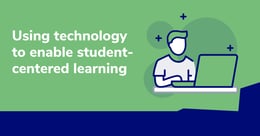
Student-centered learning vs. teacher-centered learning: An overview
The many changes posed by the 21st-century environment, and especially the rapid pace of technological innovation, mean adaptability is key for educators.
And when paired with the educational challenges spurred by the COVID-19 pandemic—think ensuring the highest-quality instruction for hybrid classrooms or addressing persistent reading and math learning gaps—educators might look toward fresh tactics to bridge the divide. The characteristics of student-centered learning make it an important approach that could help address these issues.
What do teacher- and student-centered approaches to teaching and learning look like?
A student-centered approach to teaching and learning can sometimes be complemented by what we’ll call teacher-centered tactics—as well as various other approaches to learning. This so-called teacher-centered learning approach isn’t necessarily a distinct pedagogical method, but it still reflects many real-world teaching practices that take place in classrooms today.
Once educators have a clearer understanding of both student- and teacher-centered methods of instruction, they can better decide how to integrate specific tactics in order to create a more student-centered climate in the classroom.
Student-centered learning approaches
According to the International Society for Technology in Education’s definition of student-centered learning, this approach “moves students from passive receivers of information to active participants in their own discovery process.” To create this kind of student-centered climate, educators often work with students to craft project-based individualized learning journeys that address their specific needs and preferences.
“Student-centered learning moves students from passive receivers of information to active participants in their own discovery process.”
— “Student-centered learning,” International Society for Technology in Education
[READ: “Student-centered learning: What the research says”]
Student-centered pedagogy also encourages learners to continually sharpen the skills they’ll use throughout their lives. Dr. Sarah Pazur, FlexTech High Schools’ director of school leadership, summarizes this perspective well in an article on the principles and practice of student-centered learning. “Student-centered learning mirrors what happens in life and the workplace,” she wrote. “You have to set goals, take action, manage your time, reflect and revise, and have a belief in yourself that you can improve.”
There are several distinct components of student-centered learning that teachers can deploy in a wide variety of contexts and combinations, including the following approaches.
Inquiry-based learning
With this approach to learning, educators pay special attention to learners’ questions, thoughts, and analyses. In other words, problems are considered from a learner’s rather than an instructor’s perspective.
As Dr. Andrew C. McMillan notes in an article on student-centered learning tactics, inquiry-based learning is a boon to student engagement, “leading students to move beyond basic knowledge to a deeper understanding of critical thinking, evidence-based reasoning, and creative problem-solving.” McMillan suggests using case studies, group projects, research projects, and similar approaches to emphasize this learning approach and build helpful skills in turn.
Project-based learning
Project-based learning involves creating a highly collaborative environment where students examine questions and challenges stemming from the real world. Students explore a real problem and map out solutions together, often presenting their work publicly at the end of the unit. With this, they’re able to receive knowledge that transfers seamlessly to their daily lives.
In an article on project-based learning, Katherine Hutt Scott notes that educators can still set parameters during these projects to ensure students meet required academic standards. This approach allows learners to acquire necessary knowledge while still building on the collaboration and critical thinking skills that will ensure long-term success.
Flipped classrooms and instruction
According to a guide on flipped classrooms published by Harvard University, a flipped classroom—which involves students learning the assigned material before class time rather than in class—saves time for higher-order thinking and in-class problem-solving. As a result, proponents say it encourages the kind of active learning that’s so often prized in student-centered classrooms.
Where teacher-centered learning might factor in
In contrast with student-centered instruction, teacher-centered learning encompasses the more traditional tactics educators use in the classroom. Here, the instructor functions as a leader and transmitter of information to students.
For example, this might take the form of traditional classroom lessons where the information presented is selected by the teacher. It could also involve how a lesson is delivered, such as more formal lessons where the teacher plays a heavy role, informal lessons that rely more on student interaction, or even multimedia approaches.
Several skillfully deployed tactics that might be considered more “teacher-centered” can prove to be strong complements to student-centered approaches toward learning. Some of these benefits of teacher-centered instruction include:
Clear-cut curricula
One way teacher-centered learning might factor into a student-centered environment is in the process of defining learning objectives.
By crafting a clear curriculum plan that gives learners the option to choose from a list of specific preapproved topics, educators can ensure students still focus on key learning concepts. This approach, which might be considered slightly more teacher-centered than a totally open-ended curriculum, strikes a balance between student choice and academic standards.
In this same vein, teachers might decide to clearly define project parameters themselves to ensure students stay on track with specific exercises or skills.
Interactive lessons that impart foundational knowledge
The old-school classroom lesson is often the first thing you’ll think of when picturing teacher-centered learning. But when carried out thoughtfully, it still brings a variety of benefits for students and diversifies instruction.
Remember that lectures don’t have to be one-way experiences. Rather than viewing teachers as the ones delivering information and students as passive participants and receivers, teachers can aim for a more balanced interactive and social experience during these types of lessons. Pausing lessons for more interactive classroom activities—think hosting a mini game show during a lesson—is a great way to achieve this. In this way, this kind of “teacher-centered” approach still aligns with a student-centered learning process in the long run.
Student-centered learning vs. teacher-centered learning: Why they’re not a dichotomy
District leaders and educators who want to make a change to address today’s challenges don’t need to frame student- and teacher-centered learning as all-or-nothing endeavors set in opposition to each other. In the quest toward creating an overall environment that celebrates student-centered learning moments, they’re free to pick and choose tenets from both that suit the various needs of their learners.
When aligning with a student-centered approach to learning, educators shift their focus to individual students’ needs, using collaboration and communication to create tailored self-directed learning plans. Students are able to select the learning approaches that work best for them—even if their preferences are slightly different than their peers’. But no matter the methods used to foster student-centered education, the result is often a heightened sense of student agency in the classroom, as Kevin M. Wong states in a recent article in Educational Technology Research and Development.
[READ: “K-12 leadership guide: 8 priorities for 2023”]
With this in mind, student- and teacher-centered learning don’t necessarily represent a dichotomy. These two educational approaches can both play a role in ensuring educators have a wide array of teaching tactics to choose from when fostering engaging learning experiences tailored to students’ individual needs.
Seeking more insights on how to incorporate a student-centered model of learning into your district’s educational toolkit? Look no further than Paper’s all-encompassing K-12 guide on learner-centered approaches to education.

